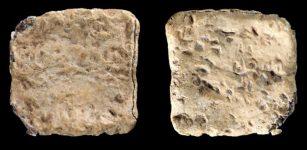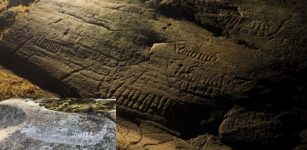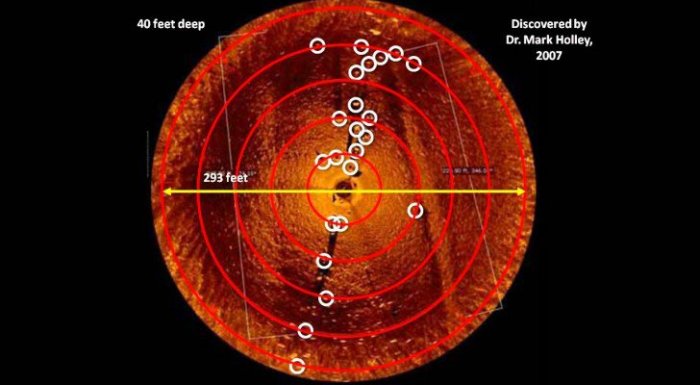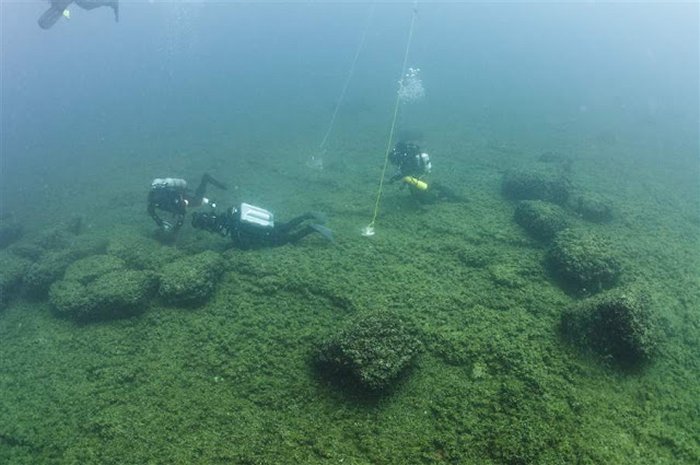Is The Intriguing Underwater Structure Beneath Lake Michigan Man-Made Or A Natural Formation?
Jan Bartek - AncientPages.com - Ancient underwater ruins are as important and intriguing as anything prehistoric we discovered on the surface of the Earth. There are still many unexplored, submerged ancient villages, whole cities, massive monuments, and artifacts that, if properly examined, could help us answer many questions about humans' distant past.
Often built by lost or forgotten civilizations, these ancient structures are memories of long-gone times.
Sonar image of the stones beneath the Waters of Lake Michigan. Credit: Dr. Mark Holley
Sometimes, scientists encounter mysterious ancient underwater structures that, unfortunately, sooner or later become forgotten.
Such is the case with an odd structure discovered beneath Lake Michigan in the United States.
Dr. Mark Holley from the University of Michigan is a trained operational/scientific diver who has years of "experience in the survey of underwater prehistoric sites and has been principal investigator for several surveys of underwater sites in Scotland, Ireland, Greece, and the United States." 1
One of Dr. Holley's most puzzling underwater discoveries occurred when he was searching for shipwrecks in Lake Michigan, and instead, he stumbled upon something totally unexpected.
Grand Traverse Bay, the northeastern arm of Lake Michigan, is famous for underwater shipwreck dive sites often visited by underwater archaeologists and adventure-seeking tourists.
About 40 feet beneath Lake Michigan's glowing waters, Dr. Holley discovered stones arranged in a long line, over one mile in length.
According to some sensational news stories, one of the boulders, about three and a half to four feet high and five feet wide, had a mastodon carving on it! How was it possible when the animal had been extinct for about 11,00 years?
There is no scientific evidence the rock has a mastodon carving. These are merely scientifically unsupported assumptions.
Dr. Holley shows the rock with what some interpret as a mastodon carving. No scientist has yet confirmed this is a rock carving of the long-extinct animal. Credit: Dr. Holley
Lake Michigan's prehistoric site reminds of a smaller version of Stonehenge in the U.K. The "rocks found under Grand Traverse Bay range in size from a basketball to a compact car.
Dating on the stones traces back to around 9,000 years ago. That is 4,000 years before Stonehenge was built and around two thousand years after the Ice Age ended. It was at a time when the lake bed was dry and before Grand Traverse Bay existed." 2
Everything indicated the submerged stones had been arranged intentionally. The curious submerged formation is often called Lake Michingan's Stonehenge, but no researchers have called it a "Stonehenge."
"This site seems to gain a life in the media about every six months or so. Sadly, much of the information out there is incorrect. For example, there is not a henge associated with the site and the individual stones are relatively small when compared to what most people think of as European standing stones.
Credit: Dr. Holley
It should be clearly understood that this is not a megalith site like Stonehenge. This label has been placed on the site by individuals in the press who may have been attempting to generate sensation about the story and have not visited the site. The site in Grand Traverse Bay is best described as a long line of stones which is over a mile in length," Dr. Holley said.1
The underwater formation in Lake Michigan. Credit: Dr. Holley
The precise location of the Lake Michigan "Stonehenge-like" structure remains shrouded in secrecy. "Upon his discovery, Dr. Holley extended the courtesy of informing the Grand Traverse Band of Ottawa and Chippewa tribes—a gesture of respect toward their ancestral heritage and a safeguard against accidental destruction of the site. As a result, the exact coordinates of this archaeological marvel are withheld from the public domain. 3
Who raised the puzzling underwater structure, and for what purpose? Is it made or a natural formation? Had Dr. Helley found evidence of an unknown 9,000-year-old civilization that once lived around Lake Michigan?
Lake Michigan's underwater "Stonehenge" was discovered in 2007. Still, little news about the site has emerged recently.
It is, however, not the only strange prehistoric submerged site in this region.
As AncientPages.com reported in 2014, while exploring Lake Huron, one of the five Great Lakes of North America, underwater archaeologists found traces of an ancient lost civilization twice as old as Stonehenge and the Great Pyramids of Egypt.
Scientists were thrilled when U.S. radar suddenly detected an odd structure at the bottom of Lake Huron. This was the first puzzle piece that led to a 9,000-year-old discovery.
Dr. John O'Shea from the University of Michigan noticed the peculiarity and, through a leap of innovative thinking, concluded that the structure was perfect for caribou hunting corridors. He then assembled a team to explore the ridge and what he found was groundbreaking.
As reported, underwater archaeologists have seemingly found what was once a dry land corridor connecting northeast Michigan and southern Ontario. Scientists say the main feature, dubbed the Drop 45 Drive Lane, is the most complex hunting structure found beneath the Great Lakes to date. The 9,000-year-old limestone structure comprises two parallel lines of stones leading to a cul-de-sac lined with natural cobble. If the findings are correct, it would make the hunting complex twice as old as Stonehenge.” 4
In 2022, “underwater archaeologists from the University of Texas at Arlington have confirmed the 9,000-year-old stone tool artifacts discovered in Lake Huron originated from an obsidian quarry more than 2,000 miles away in central Oregon.
There is still much to learn about Lake Huron's ancient structures. Credit: Tane Casserley
The obsidian flakes from the underwater archaeological site represent the oldest and farthest east confirmed specimens of western obsidian ever found in the continental United States.” 5
If we add to this the discovery of strange circle boulders on Beaver Island, the story becomes even more fascinating. Beaver Island is the largest island in Lake Michigan.
1985 a circular stone arrangement was found on the island's western side. When the site was examined, Native American elders from the surrounding areas recalled stories of a stone calendar on Beaver Island, near Peshawbestown, a historic Native American village. At this place, there is a large stone with unknown markings in the center of the site, with other rocks seemingly arranged around it.
“The stones and boulder arranged around it also have carvings, which appear to be sheaths of feathers. While no carbon dating or other analytical studies have been done on the site, it is mostly accepted that the site had a high significance and was used as an important, ceremonial site for Native Americans who once inhabited Beaver Island.” 6
The discoveries mentioned above could easily open a new chapter in the ancient history of North America. Unfortunately, the archaeological finds have been neglected and even forgotten.
Without further research and analysis, it is impossible to determine whether these underwater structures are the work of Mother Nature or an ancient unknown civilization.
Written by Jan Bartek - AncientPages.com Staff Writer
Updated on June 24, 2024
Copyright © AncientPages.com All rights reserved. This material may not be published, broadcast, rewritten or redistributed in whole or part without the express written permission of AncientPages.com
Expand for referencesMore From Ancient Pages
-
 2,500-Year-Old Mummy Workshop Discovered At Saqqara Necropolis, South Of Cairo, Egypt
Archaeology | Jul 18, 2018
2,500-Year-Old Mummy Workshop Discovered At Saqqara Necropolis, South Of Cairo, Egypt
Archaeology | Jul 18, 2018 -
 Ereshkigal – Ruler Of The Sumerian Underworld And Most Feared Deity In Mesopotamian Pantheon
Featured Stories | Mar 16, 2017
Ereshkigal – Ruler Of The Sumerian Underworld And Most Feared Deity In Mesopotamian Pantheon
Featured Stories | Mar 16, 2017 -
 Gefjon: Norse Fertility Goddess Who Knew Humans’ Fates, And Plowed Away Part Of Sweden To Give It To Denmark
Featured Stories | Nov 22, 2019
Gefjon: Norse Fertility Goddess Who Knew Humans’ Fates, And Plowed Away Part Of Sweden To Give It To Denmark
Featured Stories | Nov 22, 2019 -
 Rare ‘Cursed’ Tablet Predating The Dead Sea Scrolls Discovered On Mount Ebal Could Re-Write History – Scientists Say
Archaeology | Mar 25, 2022
Rare ‘Cursed’ Tablet Predating The Dead Sea Scrolls Discovered On Mount Ebal Could Re-Write History – Scientists Say
Archaeology | Mar 25, 2022 -
 Seshat: Goddess Of Astronomy Aligned Sacred Monuments To The Stars Long Before Imhotep
Egyptian Mythology | Mar 15, 2018
Seshat: Goddess Of Astronomy Aligned Sacred Monuments To The Stars Long Before Imhotep
Egyptian Mythology | Mar 15, 2018 -
 Remarkable South-Pointing Chariot – Ancient Cybernetic Machine Invented 1,700 Years Ago Is An Engineering Masterpiece
Ancient Technology | Jul 17, 2014
Remarkable South-Pointing Chariot – Ancient Cybernetic Machine Invented 1,700 Years Ago Is An Engineering Masterpiece
Ancient Technology | Jul 17, 2014 -
 Bizarre Sound Of A Crash Remains An Unexplained Mystery
Featured Stories | Oct 22, 2020
Bizarre Sound Of A Crash Remains An Unexplained Mystery
Featured Stories | Oct 22, 2020 -
 Ancient Indian Text Re-Writes History Of Number Zero And Mathematics
Archaeology | Sep 15, 2017
Ancient Indian Text Re-Writes History Of Number Zero And Mathematics
Archaeology | Sep 15, 2017 -
 Ancient Alaskans Were Freshwater Fishers – Earliest Evidence Found
Archaeology | Jun 19, 2023
Ancient Alaskans Were Freshwater Fishers – Earliest Evidence Found
Archaeology | Jun 19, 2023 -
 Amergin: First Druid And ‘Wondrously Born’ Son Of Mil, Founder Of Poetry, Was Judge In Irish Mythology
Celtic Mythology | Mar 3, 2022
Amergin: First Druid And ‘Wondrously Born’ Son Of Mil, Founder Of Poetry, Was Judge In Irish Mythology
Celtic Mythology | Mar 3, 2022 -
 ‘Supernatural’ Sized Daughter Of Thera: Rare Masterpiece Of Greek Antiquity Revealed To The Public
Artifacts | Oct 1, 2022
‘Supernatural’ Sized Daughter Of Thera: Rare Masterpiece Of Greek Antiquity Revealed To The Public
Artifacts | Oct 1, 2022 -
 Controversial Ancient History: Did Humans Evolve From Reptilians? The Serpent Connection From Ancient Myths To Modern Science
Featured Stories | Jul 23, 2015
Controversial Ancient History: Did Humans Evolve From Reptilians? The Serpent Connection From Ancient Myths To Modern Science
Featured Stories | Jul 23, 2015 -
 Scylla And Charybdis – Legendary Greek Sea Monsters – Choosing The Lesser Of Two Evils
Featured Stories | Jan 15, 2021
Scylla And Charybdis – Legendary Greek Sea Monsters – Choosing The Lesser Of Two Evils
Featured Stories | Jan 15, 2021 -
 Mysterious ‘Las Labradas’ Petroglyphs With Roots In The Pre-Columbian Times Of Mexico
Featured Stories | Oct 9, 2020
Mysterious ‘Las Labradas’ Petroglyphs With Roots In The Pre-Columbian Times Of Mexico
Featured Stories | Oct 9, 2020 -
 Remarkable Kailashanatha Temple And Unique Passage Of Life Cycle Including Aging, Death And Rebirth
Civilizations | Mar 26, 2017
Remarkable Kailashanatha Temple And Unique Passage Of Life Cycle Including Aging, Death And Rebirth
Civilizations | Mar 26, 2017 -
 Ancient Statue Of Makara, Legendary Sea-Creature Found In Cambodia
Archaeology | Jan 29, 2020
Ancient Statue Of Makara, Legendary Sea-Creature Found In Cambodia
Archaeology | Jan 29, 2020 -
 Marble 2th Century AD Statuette Of Goddess Cybele Unearthed In Bulgaria’s Plovdiv
Archaeology | Nov 5, 2019
Marble 2th Century AD Statuette Of Goddess Cybele Unearthed In Bulgaria’s Plovdiv
Archaeology | Nov 5, 2019 -
 Huge Viking Age Mason Owned By Herigar Finally Found At Birka In Sweden
Archaeology | Jan 23, 2017
Huge Viking Age Mason Owned By Herigar Finally Found At Birka In Sweden
Archaeology | Jan 23, 2017 -
 Ancient Petroglyph Code Cracked By Archaeological Explorers
News | Apr 10, 2020
Ancient Petroglyph Code Cracked By Archaeological Explorers
News | Apr 10, 2020 -
 The Ruins Of Pennard Castle And The Tale Of Faeries’ Curse
Featured Stories | Mar 2, 2016
The Ruins Of Pennard Castle And The Tale Of Faeries’ Curse
Featured Stories | Mar 2, 2016





